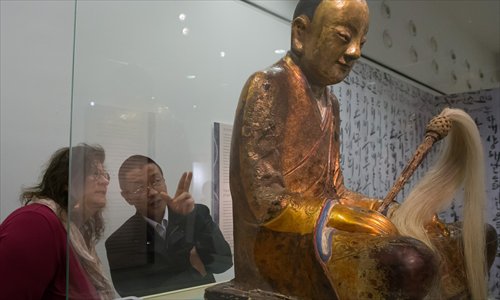
A Chinese mummy Buddha statue is admired by visitors to the Hungarian Natural History Museum in Budapest, Hungary on March 3, 2015. File photo: Xinhua/Attila Volgyi
Fujian High People's Court in East China's Fujian Province on Tuesday issued a public verdict on the case of Zhanggong Zushi, the 1,000-year-old Buddha statue with the remains of a mummified monk inside, which upheld the ruling of first instance that Dutch appealer Oscar Van Overeem should return the statue, indicating the seven-year-long litigation has come to an end.
Experts said that the case also illuminates a new path for taking back lost Chinese cultural relics overseas through legal ways which will be meaningful in similar cases in the future.
The Buddha statue was originally enshrined in Yangchun village in the city of Sanming in Fujian Province, but was stolen on December 14, 1995. The Dutch art collector Oscar Van Overeem claimed that he bought the statue in 1996 in Amsterdam, the Netherlands, but he did not provide the corresponding trading proof, according to the court.
The court believed that the statue in the lawsuit is a stolen cultural relic which was illegally exported. It has multiple natures including human remains and historical relics, which reflect the traditional customs and historical imprints of the southern Fujian regions.
The statue is a long-term worship of the local villagers, which has a special meaning to the locals, in the emotion to reason, the statue should be returned to the local villagers, said the court.
This case could be an important reference for future similar cases as the court has indicated the reasons why the Buddha statue should be returned to Chinese villagers, as the reasons are very "comprehensive" and "credible," Liu Zheng, a member of the China Cultural Relics Academy, told the Global Times on Tuesday.
Liu said that the case is meaningful to seek another important way to let overseas cultural relics return to their home of origin through "legal ways."
Indeed, in the past, we used diplomatic consultations, which is also one of the important measures to let more lost Chinese cultural relics return to their home, but there are still limitations due to various reasons, according to Liu.
China has joined the UNIDROIT Convention on Stolen or Illegally Exported Cultural Objects to prevent illegal trading of cultural relics. The convention is helpful to follow the international law and regulations to protect cultural relics, according to Liu.
Zhanggong Zushi, originally named Zhang Qisan, was a monk in China's Song Dynasty (960-1279). His body was mummified and encased in the statue, and enshrined in Puzhao Temple, which is jointly owned by the Yangchun and Dongpu villages, and was worshipped by the local villagers until it was stolen in 1995, according to media reports.
In March 2015, the statue was on display at a Hungarian museum with permission from Van Overeem, nearly 20 years after it was stolen. Yangchun and Dongpu villagers in Fujian believed that the statue was Zhanggong Zushi which was stolen from Puzhao Temple, but Van Overeem insisted that the statue was not the same one.
The two sides had some negotiations during that period but failed. The two village committees launched judicial procedures in Fujian in 2015 and in an Amsterdam court in 2016, according to Xinhua News Agency.
In December 2018, the Amsterdam court ruled the case inadmissible, saying that it is unclear whether the Chinese village committees have the right to make legal claims, according to Xinhua.
On December 4, 2020, Sanming Intermediate People's Court in Fujian ordered the Dutch defendants to return the statue of Zhanggong Zushi to its original owner - Yangchun and Dongpu village committees -- within 30 days after the verdict came into effect.
After the statue was stolen and illegally exported abroad, the Yangchun and Dongpu village committees have the right to practice ownership on behalf of the villagers to carry out cross-border pursues, and demand the illegal possessor to return the lost precious cultural relics, according to Sanming Intermediate People's Court.




